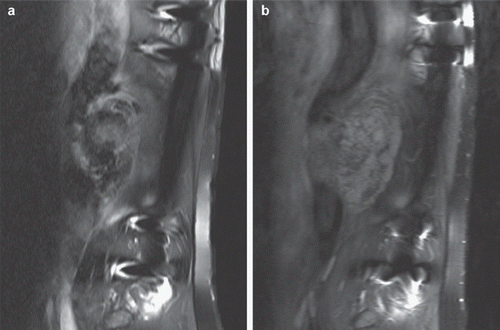To the Editor,
Here, we report the case of a 19-year-old female patient with recurrent hemangioendothelioma of the spine, who experienced long-term tumor stabilization during treatment with bevacizumab.
Hemangioendotheliomas are classified as intermediate grade malignant tumors originating from blood vessels, most commonly located in soft tissues, liver and bone. Due to their clinical behavior they are graded between the benign hemangiomas and the more malignant angiosarcomas. The most aggressive and most common variant of hemangioendothelioma is epithelioid hemangioendothelioma [Citation1]. Even though these tumors rarely develop distant metastases, more than 10% of patients initially treated with curative resection develop local tumor recurrence. Most centers would consider local radiation for unresectable disease. There is little experience with conventional chemotherapy [Citation2].
Tumors originating from blood vessels, including hemangioendotheliomas, are promoted by pro-angiogenic factors [Citation1]. Anti-angiogenic therapies as vascular endothelial growth factor (VEGF) inhibitors offer great potential in treating these malignancies. Bevacizumab, a recombinant humanized VEGF antibody is successfully being used in various types of solid tumors. As expected it has also shown great effectiveness in the treatment of tumors primarily arising from blood vessels, even though experience is limited due to the rare occurrence of these neoplasms [Citation3].
Initially, our patient presented with lower back pain in May 2005. X-ray and MRI studies showed a pathologic fracture of vertebra L1 with compression of the spinal cavity due to an intravertebral tumor. Operative stabilization was performed. Pathological examination of tumor biopsies revealed an epitheloid hemangioendothelioma of the bone. The tumor was resected with curative intent including L1 vertebrectomy and ventral spondylodesis of TH12-L2. In May 2006 the patient presented with incomplete paresis of her right leg due to local tumor recurrence. A second curative resection with extended laminectomy was performed. In July 2008, a planned follow-up MRI showed a local retroperitoneal tumor recurrence at the level of L1/2 measuring 2.5 × 4.5 × 6.5 cm (). At the time of diagnosis the patient was clinically asymptomatic. This time the tumor was judged as unresectable by two different teams of surgeons.
Figure 1. a) tumor at the time of initial diagnosis in July 2008. b) tumor after 18 months of bevacizumab treatment without signs of progression but with visible changes of tumor structure.

Because of the absence of established chemotherapeutic treatment options, on September 11, 2008 bevacizumab was started at a dose of 7.5 mg/m2 given every three weeks. To evaluate tumor response, MRI of the tumor region was performed every three months. No side effects due to bevacizumab treatment were noted.
MRI performed after 12 months of treatment showed signs of intratumoral transformation, which is suggestive of tumor necrosis.
In March 2010, 16 months after initiation of bevacizumab the patient remains asymptomatic and according to MRI without tumor progression ().
To our knowledge, this is the first report of a patient who was successfully treated with bevacizumab for local recurrent epithelioid hemangioendothelioma. Therapy with bevacizumab was tolerated with virtually no side effects. In contrast treatment alternatives as conventional chemotherapy and radiation carry the risk of substantial morbidity. The clinical course of this case mandates the further use of antiangiogenic agents in hemangioenotheliomas.
Declaration of interest: G. Folprecht reports receiving lecture and advisory fees from Roche/Genentech.
References
- Koch M, Nielsen GP, Yoon SS. Malignant tumors of blood vessels: Angiosarcomas, hemangioendotheliomas, and hemangiopericytomas. J Surg Oncol 2008;97:450–6.
- Kelly H, O'Neil BH. Response of epithelioid haemangioendothelioma to lipsomal doxorubicin. Lancet Oncol 2005; 6:813–5.
- Belmont L, Zemoura L, Couderc LJ. Pulmonary epithelioid haemangioendothelioma and bevacizumab. J Thorac Oncol 2008;3:557–8.